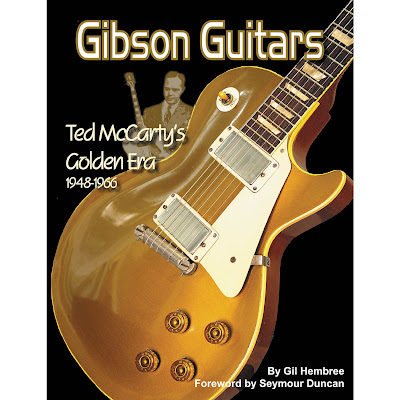Gibson Guitars: Ted McCarty's Golden Era: 1948-1966

Gil Hembree
352 pages, GH Books (February 1, 2007)
"Gibson Guitars: Ted McCarty's Golden Era" is a long overdue book that covers the world's greatest period of guitar manufacturing. As CEO of Gibson Guitars from 1948 to 1966, "Ted McCarty" presided over the production of nearly one million instruments and amplifiers. 1950s "Gibson Les Paul Standards", "Flying Vs", "Explorers", and "ES-335s" are considered to be some of the most valuable fretted instruments in the world. This book is "Ted McCarty"'s first and only complete biography, and a book that gives us a glimpse into a golden era of his factory and his loyal employees who made some of the world's most desirable guitars. It features over 100 photographs, some from Ted's personal archives and never before published. "Ted McCarty was the architect of a Golden period in Gibson's history. During his 18-year tenure, he helped to reestablish the company's historic leadership in the industry through a number of musical innovations that still resonate today". Gibson Chairman and CEO Henry E. Juszkiewicz
In 1948, Gibson hired music industry veteran "Ted McCarty", who was promoted to company president in 1950. During his tenure (1950–1966), Gibson greatly expanded and diversified its line of instruments. The first notable addition was the "Les Paul" guitar. McCarty was well aware of the strong sales of the "Fender Telecaster". In 1950, Gibson decided to make a solid-body guitar of its own according to its own design philosophy despite the fact many other guitar manufacturers were contemptuous of the concept of a solid-body guitar. Designed by the guitarist "Les Paul", it was released as his signature model in 1952. The "Les Paul" was offered in several models, including the Custom, the Standard, the Special, and the Junior.
In 1958, Gibson introduced the ES-335T model. Similar in size to the hollow-body Thinlines, the ES-335 family had a solid center, giving the string tone a longer sustain.
In the late 50s, McCarty was aware the Gibson was perceived as a "conservative" company, generally making traditionally shaped instruments. He decided to change that.
 In 1958, Gibson produced two new designs: the eccentrically-shaped Explorer and Flying V. These "modernistic" guitars did not sell initially. It was only in the late 1960s and early 70s when the two guitars were reintroduced to the market that they sold very well. The Firebird, in the early 60s, was a reprise of the modernistic idea, though less extreme. In the 1950s, Gibson also produced the Tune-o-matic bridge system and its version of the humbucking pickup, the PAF ("Patent Applied For"), first released in 1957 and still sought after for its sound.
In 1958, Gibson produced two new designs: the eccentrically-shaped Explorer and Flying V. These "modernistic" guitars did not sell initially. It was only in the late 1960s and early 70s when the two guitars were reintroduced to the market that they sold very well. The Firebird, in the early 60s, was a reprise of the modernistic idea, though less extreme. In the 1950s, Gibson also produced the Tune-o-matic bridge system and its version of the humbucking pickup, the PAF ("Patent Applied For"), first released in 1957 and still sought after for its sound.In 1961 the body design of the "Les Paul" was changed, due to the demand for a double-cutaway body design. "Les Paul" did not care for the new body style and let his endorsement lapse, and the new body design then became known as the SG (for "solid guitar").
The "Les Paul" returned to the Gibson catalog in 1968 due to the influence of players such as "Keith Richards", "Eric Clapton", "Jeff Beck", and "Peter Green". Both the "Les Paul" and the SG became very popular with rock and roll and blues guitar players.
Subscribe to:
Post Comments
(
Atom
)







0 Comments :
Post a Comment